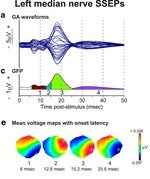Whole-scalp EEG mapping of somatosensory evoked potentials in macaque monkeys

Summary
High-density scalp EEG recordings are widely used to study whole-brain neuronal networks in humans non-invasively. Here, we validate EEG mapping of somatosensory evoked potentials (SSEPs) in macaque monkeys (Macaca fascicularis) for the long-term investigation of large-scale neuronal networks and their reorganisation after lesions requiring a craniotomy. SSEPs were acquired from 33 scalp electrodes in five adult anaesthetized animals after electrical median or tibial nerve stimulation. SSEP scalp potential maps were identified by cluster analysis and identified in individual recordings. A distributed, linear inverse solution was used to estimate the intracortical sources of the scalp potentials. SSEPs were characterised by a sequence of components with unique scalp topographies. Source analysis confirmed that median nerve SSEP component maps were in accordance with the somatotopic organisation of the sensorimotor cortex. Most importantly, SSEP recordings were stable both intra- and interindividually. We aim to apply this method to the study of recovery and reorganisation of large-scale neuronal networks following a focal cortical lesion requiring a craniotomy. As a prerequisite, the present study demonstrated that a 300-mm(2) unilateral craniotomy over the sensorimotor cortex necessary to induce a cortical lesion, followed by bone flap repositioning, suture and gap plugging with calcium phosphate cement, did not induce major distortions of the SSEPs. In conclusion, SSEPs can be successfully and reproducibly recorded from high-density EEG caps in macaque monkeys before and after a craniotomy, opening new possibilities for the long-term follow-up of the cortical reorganisation of large-scale networks in macaque monkeys after a cortical lesion.
